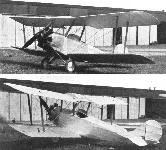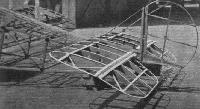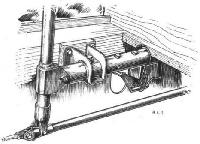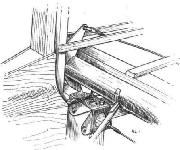
Flight, October 1929
SURREY A.L.I. BIPLANE
General Description
THIS new civil machine has been designed by Mr. J. Bewsher, for Surrey Flying Services, specially for the following uses :- (1) As a two-seater touring machine, for which the extremely comfortable accommodation and side-by-side seating, together with large luggage space, render it ideal. (2) As a school machine, in which connection side-by-side seating cannot fail to facilitate instruction. (3) As a small machine, with a large capacity, for the travelling salesman and for the transport of goods, etc. With regard to these last functions, the 10 cub. ft. of luggage space may, if a passenger is not carried, be augmented to the extent of another 3 cub. ft. of loose goods, or double this amount if securely tied up. The division in the centre of the cockpit, together with the complete flooring, etc., and disconnectable controls, enables this to be done.
The useful load allowance, with aerobatic C. of A., besides fuel and oil for 200 miles, is 400 lbs. This can be made up with pilot, passenger and/or goods or luggage. For touring, this gives an allowance of 60 lbs. of luggage with pilot and passenger; or, as a single seater, 230 lbs. of freight.
The machine may be fitted with either the 7 cyl., 95 h.p. Salmson air-cooled radial engine, or with the Cirrus air-cooled 4-cyl. in-line engine.
Specification of the machine is as follows :- Span, 28 ft. 9 in. Length, 20 ft. Height, 8 ft. 6 in. Wing area, 215 sq. ft. Height empty, 680 lbs., load (total for aerobatic C. of A.), 520 lbs. Weight loaded, 1,200 lbs.
With Salmson engine With Cirrus engine
Top speed, fully loaded 110 m.p.h. 100 m.p.h.
Landing speed, fully loaded 45 45
Cruising speed, fully loaded 100 90
Rate of climb, low down 1,100 ft./mins. 800 ft./ mins
Ceiling 20,000 ft. 17,000 ft.
Range 200 miles 200 miles.
Accommodation
The cockpit is roomy and comfortable. It is completely floored, while the sides are panelled and upholstered so that n« bracing or other structure is exposed. Side-by-side seating has a dividing armrest extending the full length of the cockpit. Properly sprung thick upholstery is supplied, making the seating as comfortable as in a motor car.
Cushions of both seats can be lifted to expose a well under each, which can be used either as a tool box or as space for a seat-type parachute. In the latter case, the cushion is dispensed with; as the well depth plus the cushion thickness is the same as the thickness of a parachute.
Luggage Space
Behind the cockpit is a large compartment, entirely floored and panelled, for luggage. It is 25 in. wide, with a mean length (fore and aft) and height of 18 in. and 30 in., respectively; having a capacity of 10 cub. ft. The opening to this compartment is at the top ; and measures 35 in. by 12 in. It can be opened either half way or entirely, as the lid is hinged along the centre of the machine and is also entirely removable without tools.
It will thus be seen that two full-size suitcases can easily be carried, in addition to quite a lot of other baggage.
Controls
Full dual controls are provided, and these are so arranged that all control mechanism other than the actual joysticks and rudder-bars are out of the way, either below the floor or inside a tunnel which runs the whole length of the cockpit. This tunnel forms a waist-high partition, carrying an upholstered armrest and preventing the passenger from accidentally interfering with the pilot. The port joystick is quickly removable; and the rudder-bar on the same side can be instantly disconnected by the operation of a convenient lever. Thus accidental interference of the passenger with the controls can be absolutely avoided.
Accessibility of the control mechanism is nevertheless, good, as lids in the side of the tunnel and removable floor boards enable it easily to be inspected and oiled.
Engine Controls
These are situated in the centre of the machine just below the dashboard, so as to be convenient to either occupant of the cockpit.
Throttle is controlled by a knob which moves straight fore and aft; an automatic device locking it positively in the desired position. The knob has a travel of 8 in., which gives a fine adjustment of throttle opening. A differential arrangement in the system also gives a finer adjustment at the beginning of the throttle opening than at the end. An altitude adjustment is by a smaller knob below the throttle control. These two controls are inter-connected forward of the fireproof bulkhead.
Instrument Board
This is handsomely fitted out with flush instruments, and is covered with leather-cloth in keeping with the upholstery. There is a large cubby-hole at each side of the instrument board for light articles such as maps, gloves, sandwiches, etc.
<...>
The machine just completed by Surrey Flying Services, is of the open cockpit type.
An optional coupe roof has, however, been designed, which enables the machine to be used either as a closed or an open one as desired.
Also, it has been suggested, and is quite worth while, that a detachable section of decking, with a cockpit opening and windscreen might replace when desired the lid of the luggage compartment.
This would then be converted into an extra cockpit for a child (seated sideways on a removable seat), so the machine could become quite a family affair!
The generous allowance of weight for pilot, passenger and luggage made on the aerobatic C. of A. would usually permit of this; and would definitely do so for non-aerobatics.
In conclusion, it might be mentioned that the Surrey Flying Services type A.L.I., though small in overall dimensions is not a "light aeroplane," but a sturdy machine designed and constructed to withstand hard usage for business, pleasure or training; and to afford the greatest ease of maintenance and repair.
Описание:
- Flight, October 1929
SURREY A.L.I. BIPLANE - Flight, April 1930
AIRCRAFT FOR THE PRIVATE OWNER
Фотографии
-
Aeroplane Monthly 1977-04 / A.Ord-Hume - Surrey Flying Services A.L.1 /British pre-war ultralights/
The Flight photographs show the A.L.1 flying at Croydon in July 1929. Built at Croydon by Surrey Flying Services earlier the same year, the A.L.1 survives in storage near Exeter.
-
Aeroplane Monthly 1977-04 / A.Ord-Hume - Surrey Flying Services A.L.1 /British pre-war ultralights/
A three-quarter rear view of the Surrey Flying Services A.L.I. It will be seen that the cockpit is behind the trailing edge of the top wing.
-
Flight 1929-10 / Flight
THE SURREY A.L.I.: Three-quarter front and three-quarter rear views of the Surrey Flying Services' biplane.
-
Flight 1929-10 / Flight
The Surrey A.L.I, biplane in skeleton, photographed from the tail, showing the shape of the fuselage and methods of construction of the main planes and tail plane.
-
Flight 1929-10 / Flight
Side view of the tail unit, revealing in particular the rib construction of the tail plane and elevators, and general simplicity of the entire empennage.
-
Flight 1929-10 / Flight
General views of rudder-bar assembly and rudder control connecting unit.
-
Flight 1929-10 / Flight
Control column with rocking tube and inter-connecting rod to the second control column.
-
Flight 1929-10 / Flight
Assembly at rear of fuselage showing rudder and elevator controls.
-
Flight 1929-10 / Flight
TYPICAL JOINTS ON THE SURREY A.L.I.: 1, Front fuselage joint with centre section strut socket and engine-mounting attachment; 2, Strut fitting on the main 'plane spar; 3, A fuselage joint, which is clearly of simple design.
-
Flight 1929-10 / Flight
Surrey A.L.I. 95 hp. Salmson AC.7 Engine
- Фотографии













